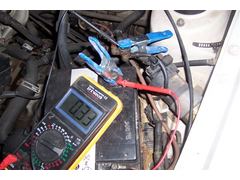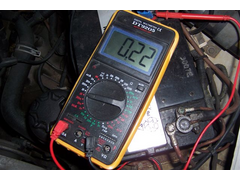Fred W B
|
| posted on 16/10/08 at 08:07 AM |

|
|
Daily driver - battery or electrical problem?
If I donít use my daily driver 1996 Opel (as seen here) for 2 or 3 days, the
battery goes flat. The dash lights donít come on and it doesnít even attempt to turn over. If I use it every day is it fine.
The battery is a year and 4 months old. Should I just spend the money and replace it as a first step, or are their some simple checks or trouble
shooting I can do first on the rest of the system myself? I have a multimeter but Iím not very skilled with it and do not have any experience with
modernish electrical systems.
Cheers
Fred W B
You can do it quickly. You can do it cheap. You can do it right. Ė Pick any two.
|
|
|
|
|
mr henderson
|
| posted on 16/10/08 at 08:12 AM |

|
|
Once you've had it running and the battery is charged up, when you park up try diconnecting the earth lead on the battery. If the battery then
keeps its charge for a few days you will know that something is drawing power even when the car is not being used.
You can speed up this analytic process by measuring the current with a meter with the car turned off, or just by seeing if there are any sparks from
the battery terminal when removing and replacing the connector
John
|
|
|
Mr Whippy
|
| posted on 16/10/08 at 08:14 AM |

|
|
1st start the car, put the meter across the battery terminals set to volts and see what the voltage is, it'll be quite low while the battery
charges 13 odd volts but it should climb slowly reaching around 14v. If itís around 12v and going down then the alternator is not charging, 15v or
more then the alternator is over charging and will damage the battery. Does your battery have caps for filling up the water (distilled only) as it may
be low. Try reving the engine, the voltage should not climb above 14v! If there is nothing wrong with the alternator then most likey its then the
battery.
Donít smoke anywhere near this btw
[Edited on 16/10/08 by Mr Whippy]
Fame is when your old car is plastered all over the internet
|
|
|
mr henderson
|
| posted on 16/10/08 at 08:18 AM |

|
|
If there is nothing substantial in the way of sparks as mentioned above, select a high current (amps) range on the meter, then disconnect a battery
lead from the positive terminal, then connect the red lead on the meter to the battery terminal and the black lead to the disconnected battery lead,
and measure the current. If there is no reading, or a very small reading, select a lower amps range.
Anything more than maybe an amp of draw is the reason for the battery drain, and needs to be investigated. The battery sounds too new to be faulty
Edited to add, Mr W's advice is OK too, he posted while I was typing
John
[Edited on 16/10/08 by mr henderson]
|
|
|
Fred W B
|
| posted on 16/10/08 at 08:20 AM |

|
|
Thanks for quick replies chaps, I'll try your suggestions.
Cheers
Fred W B
You can do it quickly. You can do it cheap. You can do it right. Ė Pick any two.
|
|
|
mad-butcher
|
| posted on 16/10/08 at 08:31 AM |

|
|
sounds like diode pack in alternator is leaking to earth. as said disconnect battery to check. Battery should be covered under warranty if it's
only 16 months old most have 2 year warranty
|
|
|
BenB
|
| posted on 16/10/08 at 08:53 AM |

|
|
As above. Go for a nice long drive so that the battery is fully-charged then disconnect the +ve battery leads.
Wait for a couple of days, reconnect the leads and try to start the engine.
If no go then the battery is self-discharging and it's shagged. If it starts then you've got a short to earth somewhere (e.g. like the
alternator pack diode)......
|
|
|
02GF74
|
| posted on 16/10/08 at 09:04 AM |

|
|
either the battery is losing its charge, unlikley with a battery of that age or else there is something draining the battery when ignition is on.
the latter can be car alarm, radio, lamp in boot - that kind of stuff.
^^^ wot they say.
put multimeter on largest amp scale and connect between battery positive wire and positive cable (red).
If there is a reading then remove the fuses umtil it reads zero.
If it does, then that would identify the circuit at fault and all you do then is to trace back the wires.
if there is still a reading, then you have something wired permanently to live (e.g. after market radio) that is drawing the current.
|
|
|
maartenromijn
|
| posted on 16/10/08 at 09:30 AM |

|
|
I agree with the above.
Another thing is that you can have batteries tested at a battery shop/ garage. They can check the power, (dis)charging etc.
BLOG: http://thunderroad-super7.blogspot.com/
|
|
|
James
|
| posted on 16/10/08 at 10:18 AM |

|
|
I'd look for a dicky door or boot switch that might mean the interior lights are on all the time.
HTH,
James
------------------------------------------------------------------------------------------------------------
"The fight is won or lost far away from witnesses, behind the lines, in the gym and out there on the road, long before I dance under those lights."
- Muhammad Ali
|
|
|
britishtrident
|
| posted on 16/10/08 at 11:24 AM |

|
|
It could be a few things first thing to do is charge the battery for at least 8 hours. Then allow it to rest for a few hours.
Battery should show about 12.4 to 12.9 volts when you put a voltmeter across it.
Reconnect
First check is to test the battery for a dead cell (sometimes called a gassing cell).
Put voltmeter across the batterry terminnals and get an assistant to start the car while you observe the battery voltage.
To do this you need to measure the battery voltage under very heavy load, without a special tester you can do this by a cranking voltage test ie
check the battery voltage when starting..
Test is best done with a decent charge in the battery and after it has been off charge for several hours
For example
12.8 volts then quickly drops to between 9 and 11 volts when starter operated pass Battery is OK
12.8 volts then quickly drops to about 6 volts when starter is operated then the battery is knackered.
12.8 volts then quickly drops to about 6 volts when starter operated but then slowly rises to about 8 volts then the battery is knackered.
If it passes the above go on to check the charging voltage on and off load.
To do this simply check the battery voltage with the engine running at 1800 to 3000 rpm. Battery voltage should now be 13.4 to 14.9 volts.
Repeat the test but with the head lamps and heated rear window switched on -- voltage should not be below 13.4 volts. Now with the engine at the
same rpm switch the lights and HRW off -- voltage should remain below 14.9 volts.
If it passes the above test either you have a drain of current when everything is switched off or the battery is simply not holding charge.
To tell which disconnect the battery overnight -- if Ok in the morning the problem is a current drain.
Most likely causes of current drains are
(1) Dud alternator diodes
(2) Aftermarket Radios and CD playes
(3) Boot or glove box light switch stuck on.
[
[Edited on 16/10/08 by britishtrident]
[Edited on 16/10/08 by britishtrident]
|
|
|
Fred W B
|
| posted on 16/10/08 at 05:37 PM |

|
|
Wow - thanks for all the responses guys.
I've had a quick look. I charged the battery overnight last night, and drove just the 22 km to work and 22 km back today.
Using the test procedure suggested by BT:
Battery shows 12.5 volts with a voltmeter across it.
Operate starter - drops to 10.4 volts
With engine running at about 2500 rpm, voltage is 14.1 volts.
Add load, voltage drops to 13.7 volts.
Remove load, voltage goes back to 14.1 volts.
Setting multimeter to what I think is the 20 Amp scale, shows 0.33 Amps between battery and terminal.
All internal lights etc seem to be off. Removing the face of the stereo, which should remove only the load needed to power the clock display in the
face, multimeter then shows 0.22 Amps between battery and terminal.
So seems I have to get into pulling fuses?
I have to use the car now, but will leave the battery disconnected overnight and see if the voltage drops.
21.00 - volts now 12.7
"edit to add"
this morning, 07.00 - volts now 12.45
Cheers
Fred W B
 
.33
 
.22
[Edited on 17/10/08 by Fred W B]
You can do it quickly. You can do it cheap. You can do it right. Ė Pick any two.
|
|
|













